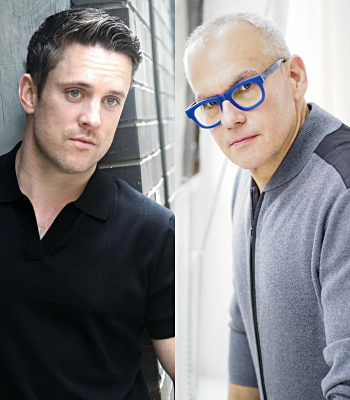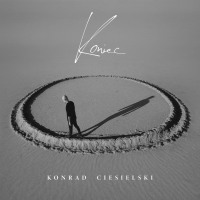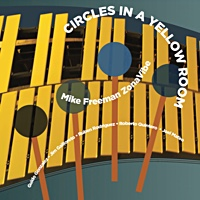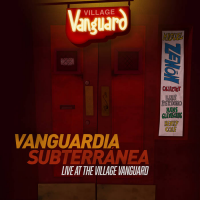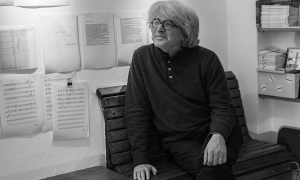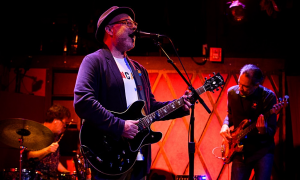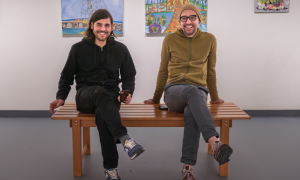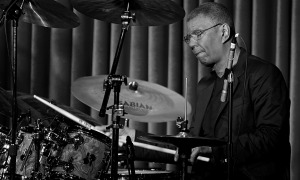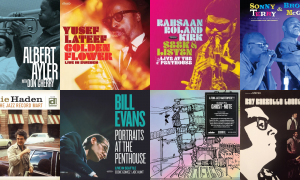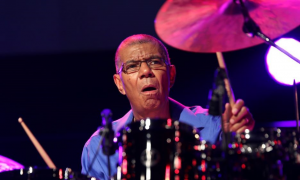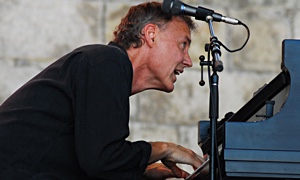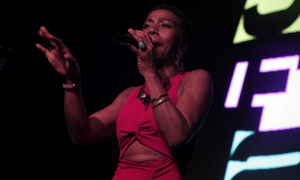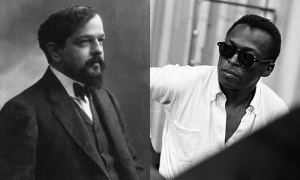Home » Jazz Articles » Interview » Kazzrie Jaxen: The Impulse of Creation
Kazzrie Jaxen: The Impulse of Creation
I'd just begun studying with Lennie, in the Fall of 1972, totally enthralled with his way of teaching, when I met Connie one day in his waiting room. We "recognized" each other immediately as friends. I asked her how long she'd been studying with Lennie. She said, "Ten years." My eyes must have popped out of my head. "Ten years? Wow! What are you working on now?" All I could imagine was—what would ten years of this be like? It was thrilling to me. Connie smiled. She understood what I was feeling!
In 1973 Connie began to play concerts in Lennie's loft attic. And once again, I heard another completely original musician. She'd created a new language with chord voicings that I'd never heard before. She'd absorbed Lennie's concepts and expanded them into her own approach to harmony and melody. I loved her music and was deeply inspired by her originality and her commitment to the art form. During this time she was recording in her studio with Roger Mancuso on drums and Joe Solomon on bass, and also solo. These recordings became her first record on Steeplechase, released in 1974. Sometime after that Lennie presented her in a solo concert at Carnegie Recital Hall. All of this was incredibly exciting to me. Lennie talked a lot about the feminine dimension that was missing from jazz and the creative arts. He felt strongly that women should be recognized for their contributions. He wanted to promote this. After Connie's first concert, he began presenting me in concerts at his home. This expanded to include other musicians. He was talking about reviving his record company, Jazz Records. In 1978 he presented me at Carnegie Recital Hall in a solo concert.
After Lennie died in November of 1978, a small group of us, including Connie, Lenny Popkin, Carol Tristano (Lennie's daughter) and Lynn Anderson, worked together to continue Lennie's projects. And I began studying with Connie, off and on, for several years. It was a continuation of what I'd been doing with Lennie, so the material was basically the same. But we'd have deep discussions about all aspects of music, and I got to experience Connie's intuitive genius as a teacher as well as a musician. Lennie had always emphasized that a teacher's function was to inspire and instruct, with inspiration being of primary importance. Connie was incredibly inspiring. She had her own way of expressing things that deepened my understanding of improvising. She was totally present, attentive, and supportive. She radiated joy and enthusiasm and was beloved by many people. Her music stands as some of the greatest music ever created. We were friends for almost 50 years, sharing lots of life and music, and our friendship continues to evolve across dimensions of time and space.
AAJ: When you think in terms of being a student, it is sometimes interpreted as repeating the philosophy of the teacher. Crothers was a student of Tristano, but as I hear it she was also a different musician than him and had a different style of playing. How do you see the differences between them and their differences and similarities in terms of aesthetic and your own place musically in relation to them?
KJ: Lennie taught each person as an individual. He always said he learned to teach from his students, and that his feeling about teaching was as deep as his feeling about playing. Though he had a basic series of practices, not everyone got into them in the same way, or to the same degree. He worked with each person from where they were and helped them to open from there. Connie described her experience this way: "When I was twenty-three I dreamed some music, but it took me a few years to understand what I had dreamed—it was different from what I knew. Thanks to Lennie's help I was able to grasp the music in my dreams and go from there. Lennie's teaching has made it possible for me to experience and express my own musical identity."
Lennie taught drummers, horn players, string players, singers, even dancers. As long as you knew the basics of your instrument, he could teach you to improvise. He taught from intuition, sensing what each person needed to express their own music. He used to pound the wall with his fist and say "It's gotta be real!" He wanted to hear authentic feeling and would always ask you, after playing, "How did it feel?" The whole purpose of his teaching was to produce people who expressed their own music—not his. But of course he was inspiring us, and we were all influenced by how much we loved his music, and each other's. I heard Connie play and it transformed my playing. She said the same thing about hearing me. We were all influencing each other. I heard Connie's influence on Lennie's playing as well—I'd sometimes hear him playing with other students from the waiting room.
Connie and Lennie were my strongest influences, and I love that I can sometimes hear both of them in my playing. Recently I was listening to three trio recordings I'd made with Don Messina and Bill Chattin that we're hoping to release—a session and a concert from 2011, and another session from 2013. I could hear the influence of Connie's abstract harmonic and rhythmic feel, especially from her early playing, in the first session; I could hear the influence of Lennie's driving line in the concert; and in the final session two years later, I heard a joyful synthesis—a feeling of freedom—I heard how loving their music had opened me to mine.
AAJ: You've also taught. Could you elaborate on your own approach and experience with teaching music and the values that are important to you as a musician and teacher?
KJ: Lennie encouraged several of us to teach. (Pianist Sal Mosca, an earlier student of Lennie's, went on to become a renowned teacher as well as player.) Bassist Joe Solomon established a teaching studio in Manhattan. Connie, Lenny Popkin, Lynn Anderson, and I became Lennie's "teaching associates." He would refer students to us, and we would consult with him. This is how we learned to teach from an improvisational perspective. Connie began to build up a full-time practice. I began by teaching children. This was an amazing education for me. Talk about real! Talk about spontaneous! Kids were natural improvisors, bursting with energy and creativity. They loved singing with records, listening to music, and playing melodies. Imagine hearing a five-year old singing along with Frank Sinatra and really swinging it; or an eight-year old singing with Roy Eldridge's "King of Bongo Bong" and then doing his own version with a keyboard and drum machine.
Over the years I was fortunate to work with many amazing people of all ages, and I learned to teach—just as Lennie said I would—from the people who studied with me. I always thought of it as a "mutual school." The exchange between teacher and student was an intuitive improvisation that unfolded over time. It was my job to keep learning and opening. As my life deepened through practices of Qigong, Meditation, and Intuitive Diagnosis, these disciplines found their way into my teaching. I think what emerged for me was the importance of being able to hold the space for someone to become the navigator of their own creative life. There's a lot of expansion and contraction that happens in the creative process. It's deep stuff. You break through to new levels of expression, then can sometimes experience what feels like a contraction. Getting familiar with the ebb and flow, so it no longer throws you, is a lifelong journey. Teaching is really about inspiring someone to love the process of learning, giving them tools to build on, and supporting them in trusting their own intelligence, creativity and originality.
Making Records
Kazzrie Jaxen has a rich and varied discography—her work for New Artists Records especially stands out, but it isn't the full story. In this third and final part of the interview, Jaxen talks about her music on New Artists Records, especially the live record Dream Flight, as well as other recordings and projects.AAJ: You have recorded a string of albums for New Artists Records, and I discovered that in your early phase of recording for the label, a trilogy of albums were recorded live at Greenwich House, NYC between 1989 and 1990: A Jazz Duet with saxophonist Charles Krachy (New Artists Records, 1990), Cosmic Comedy (New Artists Records, 1991) with guitarist Andy Fite and your solo piano record Dreamflight (New Artists Records, 1991.) Could you say something about your relation to the venue, and this period in your life that seems very productive?
KJ: I'd been playing duet sessions with Andy Fite and Charley Krachy for several years before we decided to record and perform together. This was a wonderful part of the "scene" we were part of. Informal weekly sessions, where we just got together and improvised, were the way we evolved together musically. Andy and I went into BMG recording studio in March of 1988 and released a duet CD called Phantasmagoria (New Artists Records, 1988). We gave a copy to Horst Liepolt, who was managing the jazz club Sweet Basil at the time, and he invited us to play in the Greenwich Village Jazz Festival in September 1989. That's how we found out about the venue at Greenwich House. It was centrally located, with a good piano and good acoustics.
We played a great concert, and afterward we went out to eat with a large group of our friends, to a restaurant owned by a wonderful chef and saxophonist named Anton. We often went there after concerts. We sat at a big long table. I hooked my purse on the back of my chair as I always did, and someone took it—along with the master tapes from the concert! We were devastated. We looked everywhere that night, and I took the subway into the city the next morning, searching the city streets and garbage cans and dumpsters near the restaurant. I even went to a sidewalk psychic and paid a lot of money to have her tell me I probably wouldn't find them. It makes me laugh now, but I felt terrible. So Andy and I booked the same venue for another concert in March of 1990, which became Cosmic Comedy (New Artists Records, 1991). Meanwhile, Charley and I had booked the venue for October of 1989, and that concert became A Jazz Duet (New Artists Records, 1990). Then I booked it for a solo concert for May of 1990, which became Dreamflight (New Artists Records, 1991).
When I listen to these recordings now, I hear how much I loved playing with Andy and Charley, both extraordinary musicians. But I also hear something pushing up from my subconscious, a lot of raw energy, as if an inner story is trying to get my attention. I remember that I was experiencing a lot of pain in my right arm at the time. Before every concert it would intensify, to the point of feeling paralyzed, as if I wouldn't be able to play at all. Then the energy would break through at the concert. I didn't know what was going on. It was the agony and the ecstasy—the fear of not being able to play, not being able to move my arm and fingers—and then the exhilaration of the performances when, each time, the energy would break through.
The story would begin to surface a year and a half later, in January of 1992, when I went through a 7-day kundalini experience during which I relived the moment of my conception. I know this sounds crazy, and I won't go into detail here, but it really happened. Slowly I began to realize that everything I'd been doing in music and art had been unconsciously trying to tell me the story of my life in the womb. The right arm pain, the duets leading to a solo concert—they were telling the story of being conceived with a twin, losing my companion in the womb (it's called the vanishing twin syndrome) and being born solo. (Even losing the tapes fit into this scenario!)
It actually took many years of inner work for me to discover and feel the truth of this story. And if you hadn't asked me this question, Jakob, I wouldn't have listened to those recordings in the order they were created, and I still wouldn't have put it all together in the context of this series of concerts. It brought me to a new understanding of what was going on with me then, and how incredible this creative journey is. Because once the story became conscious, I was able to align with it. I was no longer stumbling in the dark. And I began to work with this conception-to-birth cycle in a positive way, reconceiving and rebirthing myself every year. And then I began sharing it with others.
AAJ: Dreamflight was recorded live and stands out as one of two solo records you have recorded for New Artists Records. It's an impressive musical statement. How much experience did you have with solo playing at that time and what do you recall about the concert and how do you look at the record and playing solo now?
KJ: I'd done a lot of solo concerts as a child, and I'd begun my jazz performing life as a soloist when Lennie presented me at Carnegie Recital Hall. Even so, I'm still exploring the freedom that comes with playing solo. And I've become more interested in the spaces between the notes—the intimacy, the fluidity. Really, you can go anywhere with your improvising when you play solo. But often there are limits we've imposed, not even knowing that they're there. I'm still learning to breathe, to relax into the silence, to give myself permission to be myself. I've also done a lot of free-flowing extended solo playing in concerts and in private sessions, putting people under the piano and playing into their bodies. During Covid, I put a globe of the world under the piano and played into it every morning, sometimes for two hours straight, starting around 5am. Playing from darkness to light.
As for Dreamflight, I'd listened to it a few years ago and couldn't stand it! I don't think I got through the whole thing. Just took it off, couldn't listen to it! Then, because you asked me about it, I listened again recently and heard—loud and clear—the womb/birth story pushing through my subconscious. I took in the arc of this series of concerts, as discussed in the previous question, and it astounded me.
What is improvising? Moment-by-moment creation. What are we experiencing in the womb? Moment-by-moment creation. For some reason, I was led to this art form to tell this story. And it's a beautiful story, bringing forth something deep about the feminine dimension of creative expression. I'm not even sure yet how this all comes together, but I'm living it.
Now I hear Dreamflight as the story of my birth. I can listen to the wild energy of the music and breathe into it. I can hear the desperation of the body wanting to tell the story, because it's a healing story. And I can hear the beauty. Just look at the titles: "Chord Storm" and "Pulsation" (think of the umbilical cord); "A Different Kind of Melancholy" and "You'd Be So Nice To Come Home To" (twin loss); "Blues From a Subterranean Galaxy," "Dreamflight," and "Deep Awakening" (birth.) I had no consciousness of any of this when I played the concert, or when I came up with those titles. But now I do.
There's a fascinating book, Primal Connections, by Elizabeth Noble, which gives a lot of information about all of this. Also, Birth Without Violence by Frederick Leboyer is one of the greatest books I have ever read. It's poetry. It's art. It's a miracle. I hope someday to create an audio version of this masterpiece. It's a book I read every year on my birthday.
AAJ: You've worked with many different musicians, but I mostly know your work on NA. I would like to hear about your other record projects and constellations that haven't been documented on the label.
KJ: My first two recordings were released on Jazz Records, a label originally established by Lennie and now under the direction of Lennie's daughter, Carol, and her husband Lenny Popkin. The first was a double album, a solo record of a concert at Carnegie Recital Hall in 1979, arranged by Lennie before his death as a follow-up to the first concert in 1978. It's called I Feel Like I'm Home (Jazz Records, 1979). When I listened to this record after not having heard it for over 40 years, I was genuinely surprised. It's almost all free playing, and the overall feeling is lighter than I remembered, even humorous at times. There are four vocal tracks which are beautiful and emotional. I also hadn't remembered that I'd spoken two poems I'd written. One of these, "Before Flight," was perhaps the first unconscious expression of my birth story. The music that I played in response to it was especially powerful.
The second album on Jazz Records was a trio with Lenny Popkin on tenor sax and Eddie Gomez on bass entitled True Fun (Jazz Records, 1985). It was recorded in 1984. We played three stretches based on standards, and there's also a freely improvised suite inspired by three of Vincent Van Gogh's paintings: "The Sower," "Self- Portrait," and "Wheat Field with Crows." At the time, there was a big exhibition of Van Gogh's paintings at the Metropolitan Museum of Art. I used to reserve a ticket for the first time slot in the morning and walk all the way through the rooms to the back end of the exhibit. Then I'd slowly work my way forward. So I'd have several rooms all to myself, as the crowd was always going the other way. I went often, immersing myself in his paintings, standing in front of them, feeling Vincent's energy. I was also reading his letters to his brother Theo. Though we weren't thinking about the paintings when we improvised the music, as soon as I heard those tracks, I heard the influence of my experience with Vincent and literally "saw" these three paintings in my mind's eye. To this day, I'm amazed at how those three tracks sound like the paintings, and I love the entire record. Playing with Lenny and Eddie was an incredible experience.
These two records are available as LPs only on Jazz Records. I also want to mention that Lenny Popkin was the recording engineer on both dates, using reel-to-reel tape, and the sound is beautiful.
In 2003 I released a CD on my own entitled Prayers and Mad Laughter (New Artists, 2003) and was going through a lot of changes, we weren't sure what was happening with the label, and I had just legally changed my name from Liz Gorrill to Kazzrie Jaxen. I wasn't sure how all of this was going to unfold, and I felt a bit awkward about the name change. So I decided to put this one out myself. This was very personal—an expression of the death and rebirth I'd been going through in my healing process, which felt like a reflection of a global death and rebirth as well. It's a multi-tracked piano album. It begins in the two-dimensional world which is visible, rhythmic, content-oriented, with glimpses of a world beyond. ("Counterpoint," two pianos.) Then it bursts into laughter which, according to the Sufi poet Hafiz, is "the soul waking up." ("Adam and Eve, Take 2.") The laughter serves as a doorway into the multi-dimensional realm which is universal, invisible, vibrational, not bound by time or space, beyond content. ("Re-Creation," six pianos and six voices.) I've always envisioned this last piece as dance—a stage filled with wild wailing women giving birth to unity through chaos.
In 2013 Cadence Records released Callicoon Sessions (Cadence Records, 2013). Charley Krachy (tenor sax), Don Messina (bass), Bill Chattin (drums), and I had begun sessioning once a month at my studio in upstate NY. Don always brought his Sony DAT recorder to the sessions, so we were able to listen to everything we did. This CD emerged naturally out of a relaxed playing scene between 2009 and 2011. One of the tracks is from our very first session. We all thrived in this atmosphere, and it's reflected in the music. We were together for seven years, evolving as players and performers. We released our second CD—from live performances—on New Artists in 2016— Quaternity (New Artists Records, 2016).
In 2021 Vijay Anderson invited me to be part of a beautiful tribute CD: For Diane: Piano Solos for Diane Moser (Minus Zero (2), 2017). It features seven pianists, including friends Carol Liebowitz, Virg Dzurinko, and Mara Rosenbloom. I contributed two freely improvised pieces, "Fragrance from the Realm of Spirit" and "The Enlightenment of Plants."
I've also been involved in the creation of three award-winning short films: Dear Director, Beautiful HIlls of Brooklyn and Odd Duck produced by Jeff Pearring, animated by Bill Plympton from music improvised by Jeff Pearring, Ken Filiano.
In 2003 and 2004 I created and performed a theatre piece—a one-woman show entitled "Kazzrie in Boogie and Blue." This was intended to be an initiation into my new name—a way to celebrate my life as Liz Gorrill and grow into my new life as Kazzrie Jaxen. I'd never planned on changing my name—it just happened as part of the healing journey I was on. Some people flow easily with name changes, but for me It felt like an act of courage. I needed to support my decision through this performance, which turned out to be extremely cathartic. I performed original music, stories, poetry, and projected original artwork on a screen behind me. We were only allowed to have one camera for videotaping, so the artwork isn't visible on the two selections I've posted on you tube. I'm hoping to release the entire performance as a DVD, with the artwork edited in.
1994 was the beginning of the modality I now call "Dreaming In Music." This was transmitted to me by the river, trees, stones. It wasn't an idea I had—it didn't come from my mind. It just began happening and is still evolving to this day. It's a way of working with people in private sessions using sound, nature, water, vibration, and art to reawaken the conception-to-birth cycle, ignite creativity, and celebrate nature. Each part of the session, from being at the river, to lying under the piano for a sound bath, to drinking water from a vessel that holds the vibration of the music, has been transmitted to me over time by nature. Learning to trust this intuitive information has been a gradual process. In 2010 I created a performance in which I took this work to a larger audience. I hope to release a recording of that performance in the near future.
Finally, there are ongoing projects and unreleased sessions: duets with drummer Roger Mancuso, alto saxophonist Gary Levy, pianist Virg Dzurinko, and drummer Thurman Barker; a trio with alto saxophonist Chris Aiello and bassist Don Messina, and a trio with Don Messina and drummer Bill Chattin.
I've been working on another poetry/music project for the past few years. Connie was deeply connected to Emily Dickinson's poetry. Our last time together, a few days before she died, we traded Emily's poems back and forth, reading them to each other. A few months later I stood up from the piano one day after playing, and there were Connie and Emily, one on either side of me, pouring their music and poetry into my head! A lightbulb went on in my brain. What a fantastic idea! I felt like I was being invited to set Emily's poetry to Connie's jazz compositions—and then to sing and play them together. Wow! What a wild exercise, I thought. To have these two genius artists—these bright originalities- -combine inside of me! Of course it felt utterly impossible, but oh so exciting—could I attempt to do this? Just for starters, how would I ever find the right poem to fit a particular jazz composition? That alone felt daunting. There were over 1000 poems in the book I had, and I was familiar with only a handful. I'd memorized two. I knew Connie's lines from hearing her play them, but I had never played them myself, and they were complex. Even if I could find the poem to fit the line, how on earth was I going to be able to play them and sing them at the same time?
Well, here's where it gets interesting. The two poems that I already knew by heart fit perfectly with the first two lines Connie had ever written. And that was just the beginning. What I thought was a wonderful idea for an exercise became a three-way collaboration, creating a beautiful work consisting of all nine lines that Connie wrote, and seventeen of Emily's poems. It's been an amazing experience of love and joy. I'm thrilled to say that I'll be performing this material and hopefully releasing a recording this year.
AAJ: Finally, how would you sum up your musical journey so far?
KJ: When I was in my twenties, I made a youthful declaration: "I want to learn to improvise so I can align with Creation!" I can't say I knew exactly what I meant by this, but in my mind I pictured a vast musical improvising Universe out there somewhere. The art form of jazz felt like an invitation to have an intimate relationship with that Universe. I didn't realize this declaration would also take me on an inward journey—back in time to my own creation and the primal story of my life in the womb. (What do they say? Be careful what you wish for?) A couple of years ago a beautiful word appeared in my head—like a gift—that seemed to sum it all up: "Bioimprovising." It brought everything together for me. Life Improvising! Of course!
When I think of this musical journey, I get the image of a breath. The first part is the inhale—all the excitement, the learning, the new energy—the thrill of creating music that reflects the outer world and begins to excavate the unconscious inner world. Then after plummeting the depths, dying to the self you thought you were, comes the exhale—music that no longer merely reflects the world, but creates the world.
Many people believe there's an awakening taking place on this planet, that we're evolving from unconscious creators into conscious creators. To create the world we want to live in, to consciously dream it into being, we need to generate and celebrate the energy of creation. I don't think there's anything more important than this. Each one of us has a part to play in our collective dream-shifting. And it's very concrete, very real. Science is now confirming what ancient spiritual traditions and shamans have known all along- -the Universe isn't "out there somewhere." It's here, inside of us. We ARE the Universe—and we're each other. We're all part of one quantum field of energy. This means we can no longer define ourselves in terms of finite form. We're also infinite and formless. Our human operating system is in the process of adapting to this new awareness, and it's changing everything—the way we relate to each other, the way we create with each other. We're in the midst of an evolutionary leap—the birth of a new consciousness on this planet.
With this in mind, I'm envisioning new kinds of performances, recordings, and collaborations—new ways in which improvising can be interwoven into life. I want to share the story of my unusual experiences and present the music, art, and modalities that have arisen from these experiences. In addition to the upcoming projects I've mentioned in this interview, I'm excited about ongoing collaborations and new connections with musicians and artists. "Bioimprovising" feels like the DNA for this new part of my musical journey.
Tags
PREVIOUS / NEXT
Support All About Jazz
 All About Jazz has been a pillar of jazz since 1995, championing it as an art form and, more importantly, supporting the musicians who make it. Our enduring commitment has made "AAJ" one of the most culturally important websites of its kind, read by hundreds of thousands of fans, musicians and industry figures every month.
All About Jazz has been a pillar of jazz since 1995, championing it as an art form and, more importantly, supporting the musicians who make it. Our enduring commitment has made "AAJ" one of the most culturally important websites of its kind, read by hundreds of thousands of fans, musicians and industry figures every month.







